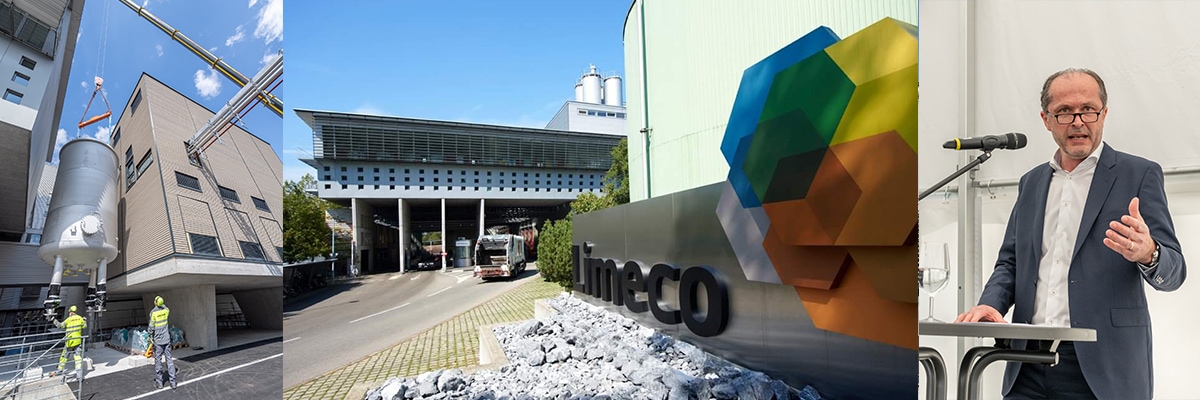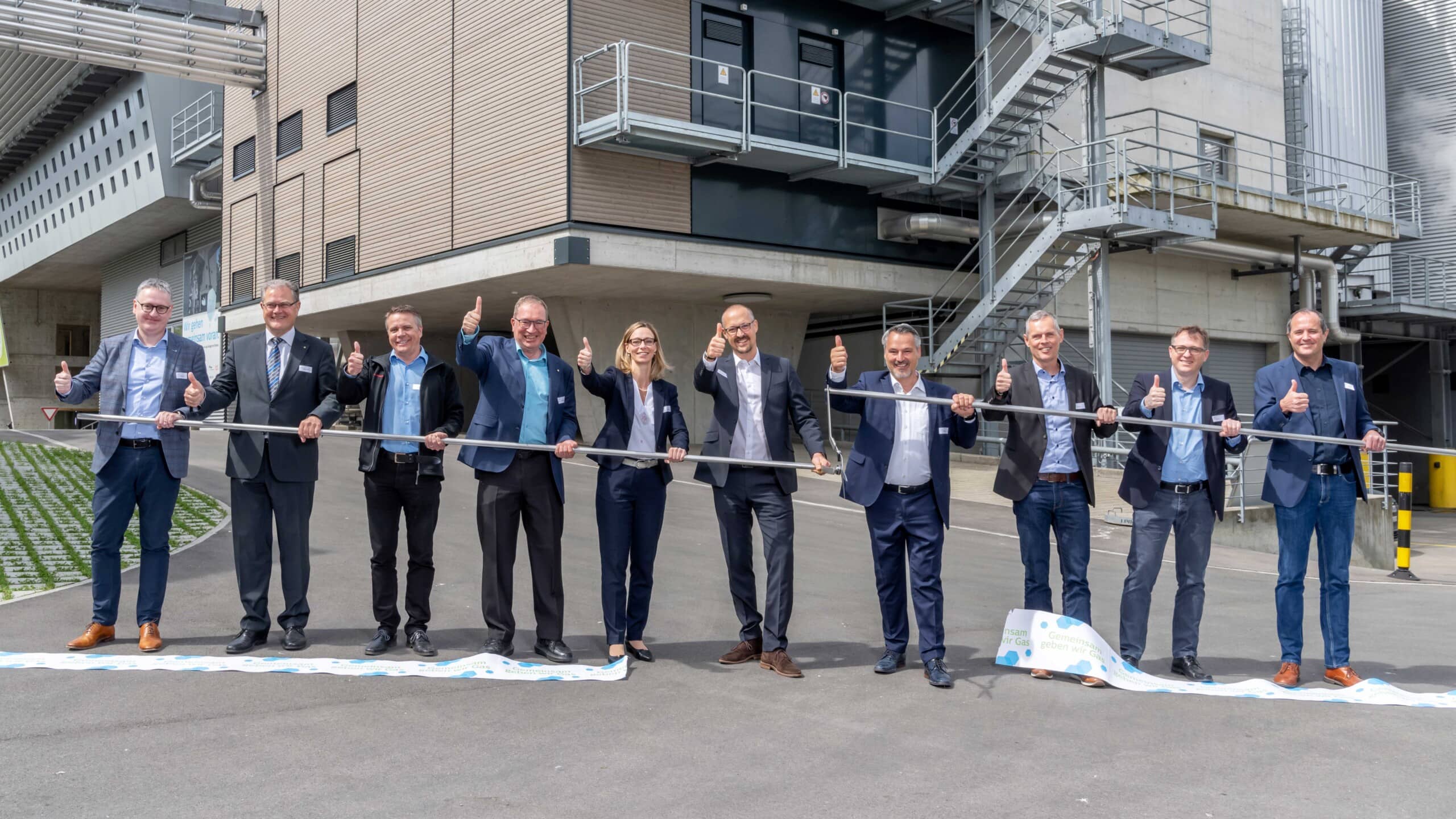Portal for more climate-friendly mobility

Limeco supplies synthetic gas
Limeco has commissioned Europe’s first industrial power-to-gas plant based on biological methanation in Dietikon (Canton of Zurich).
 Official inauguration of the power-to-gas plant (from left to right): Roger Bachmann (City President Gas and Water Supply Dietikon), Hans-Kaspar Scherrer (CEO Eniwa), Armin Glanzmann (Head of Department Works, Supply and Facilities Gas and Water Supply Schlieren), Markus Blättler (Managing Director SWL Energie AG), Cornelia Mellenberger (CEO Energie Wasser Bern), Thomas Di Lorenzo (Head of Wastewater Management Limeco), Thomas Peyer (Senior Consultant Swisspower AG), Ernst Uhler (CEO Energie Zürichsee Linth), Peter Graf (Head of Energy, Sales and Marketing St. Galler Stadtwerke) and Peter Heim (CTO Industrielle Betriebe Interlaken). Source: Limeco
Official inauguration of the power-to-gas plant (from left to right): Roger Bachmann (City President Gas and Water Supply Dietikon), Hans-Kaspar Scherrer (CEO Eniwa), Armin Glanzmann (Head of Department Works, Supply and Facilities Gas and Water Supply Schlieren), Markus Blättler (Managing Director SWL Energie AG), Cornelia Mellenberger (CEO Energie Wasser Bern), Thomas Di Lorenzo (Head of Wastewater Management Limeco), Thomas Peyer (Senior Consultant Swisspower AG), Ernst Uhler (CEO Energie Zürichsee Linth), Peter Graf (Head of Energy, Sales and Marketing St. Galler Stadtwerke) and Peter Heim (CTO Industrielle Betriebe Interlaken). Source: Limeco
Together with eight Swiss energy suppliers and the Swisspower municipal services alliance, the Limeco regional power plant launched a flagship project for the modern energy sector and has now realised it. The site in Dietikon in the Canton of Zurich was of key importance here, as the existing waste incineration plant (WIP) and the wastewater treatment plant supply the essential ingredients for the power-to-gas process, electricity and sewage gas directly on site. “That’s why Limeco has the perfect conditions here to produce green gas,” explained Stefano Kunz, Chairman of Limeco’s Board of Directors and Schlieren City Councillor.
The industrial power-to-gas plant uses renewable electricity from the WIP to split water into oxygen (O2) and hydrogen (H2) by means of electrolysis. In a second process step, this hydrogen, together with sewage gas from the wastewater treatment plant, is fed into the methanation reactor of HZI Schmack, a subsidiary of Hitachi Zosen Inova AG. In the bioreactor, microorganisms convert hydrogen and the CO2 contained in the sewage gas into methane (CH4) under anaerobic conditions. This methane is then purified and can be fed into the local gas grid as a CO2-neutral natural gas substitute.
 Zurich cantonal councillor Martin Neukom sees the plant as proof that the canton can become climate-neutral by 2040. Source: Limeco
Zurich cantonal councillor Martin Neukom sees the plant as proof that the canton can become climate-neutral by 2040. Source: Limeco
With an electrolysis capacity of 2.5 megawatts, the industrial PtG plant produces around 18,000 megawatt hours of synthetic, renewable gas per year. This enables end customers to heat, cook or refuel vehicles with a CNG engine – from small cars to large trucks – and thus operate in a CO2-neutral manner. As a result, the plant makes an important contribution to decarbonisation, as its green gas can result in up to 5,000 fewer tonnes of CO2 emissions per year, which corresponds to the CO2 emissions of around 2,000 households.
“It is crucial that Switzerland becomes less dependent on foreign natural gas,” explained Benoît Revaz, Director of the Swiss Federal Office of Energy, at the inauguration ceremony. “The power-to-gas plant shows that domestic production of renewable gas is possible.” And National Councillor for the Swiss Social Democratic Party, Eric Nussbaumer, emphasised: “Power-to-Gas contributes not only to climate neutrality, but also to responsible economic policies.” For Zurich Cantonal Councillor, Martin Neukom, the complex also shows just how progressive the Canton of Zurich is: “We want to be climate-neutral by 2040. Limeco and its partners are proving that this is possible – also thanks to innovative technologies such as power-to-gas.”
 The first industrial power-to-gas plant in Dietikon ZH helps save up to 5000 tons of CO2 annually. Source: Limeco
The first industrial power-to-gas plant in Dietikon ZH helps save up to 5000 tons of CO2 annually. Source: Limeco
This flagship project was made possible by eight Swiss energy suppliers who, as gas buyers, are helping to finance investments of around CHF 14 million: Eniwa AG, Energie Zürichsee Linth AG, St. Galler Stadtwerke, Energie Wasser Bern, the gas and water utilities of Dietikon and Schlieren, SWL Energie AG and Industrielle Betriebe Interlaken. They acquire the ecological benefits of the gas through certificates and sell it to their end customers at the exit point.
As a result, the normal operation of the power-to-gas system from mid-May will also make a decisive contribution to the restructuring of the Swiss energy system. This is because the Federal Council’s Energy Strategy envisages replacing nuclear power with solar power, hydropower and wind power by 2050. This means that in the future, much more electricity will be produced in summer than will be consumed. In winter, on the other hand, when energy requirements are greater, Switzerland has to import electricity. Thanks to power-to-gas technology, it will in future be possible to convert seasonal and temporary surpluses from electricity production into gas, thus making them storable and transportable. (pd/jas, 12 May 2022)
 Small but very important detail: HZI’s bioreactor, in which microorganisms convert hydrogen and the CO2 contained in the sewage gas to methane (CH4) under anaerobic conditions. Source: HZI/Romeo Basler – Photo Basler Aarau
Small but very important detail: HZI’s bioreactor, in which microorganisms convert hydrogen and the CO2 contained in the sewage gas to methane (CH4) under anaerobic conditions. Source: HZI/Romeo Basler – Photo Basler Aarau
You might also be interested in

Shell Starship on record hunt
